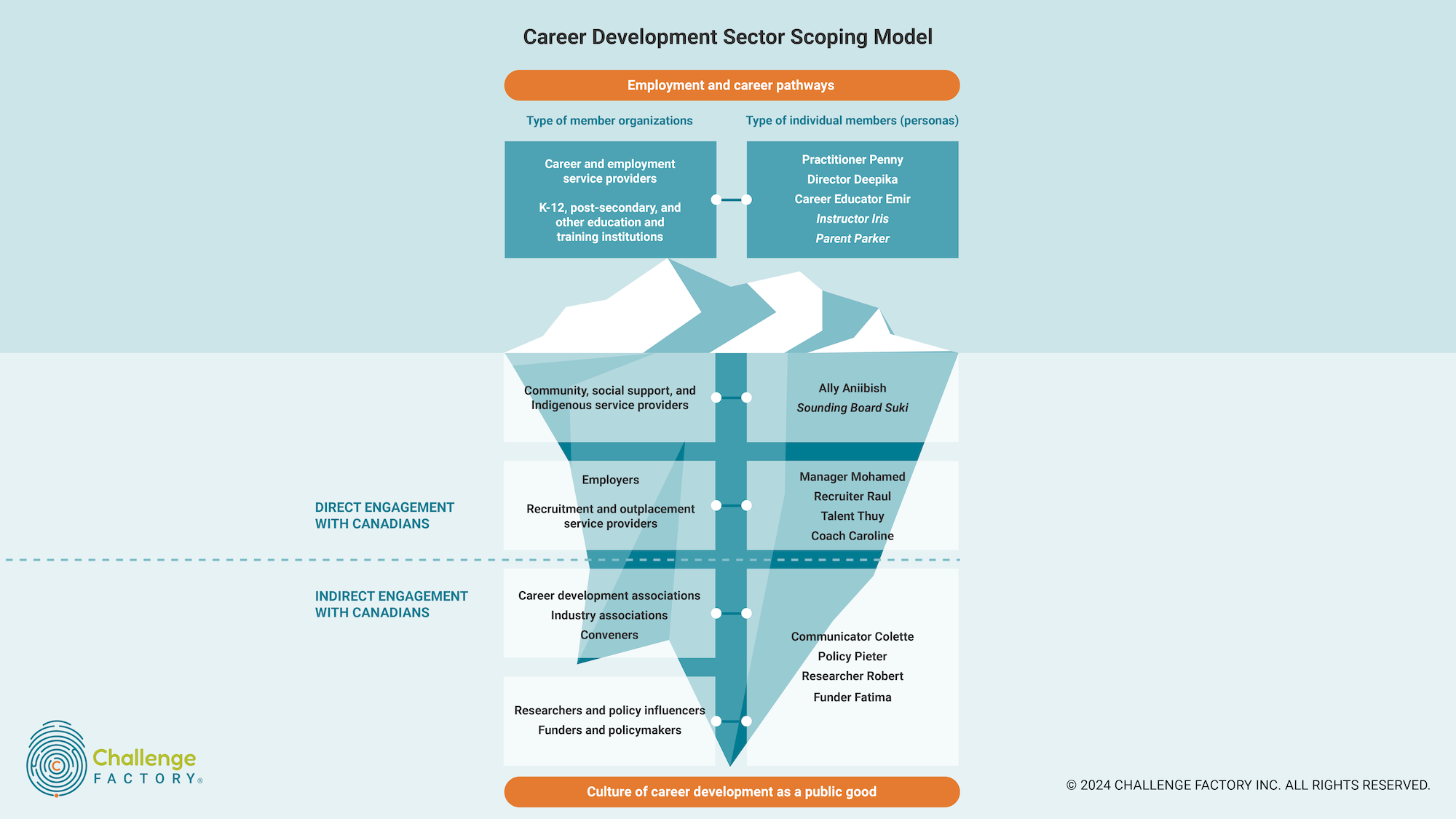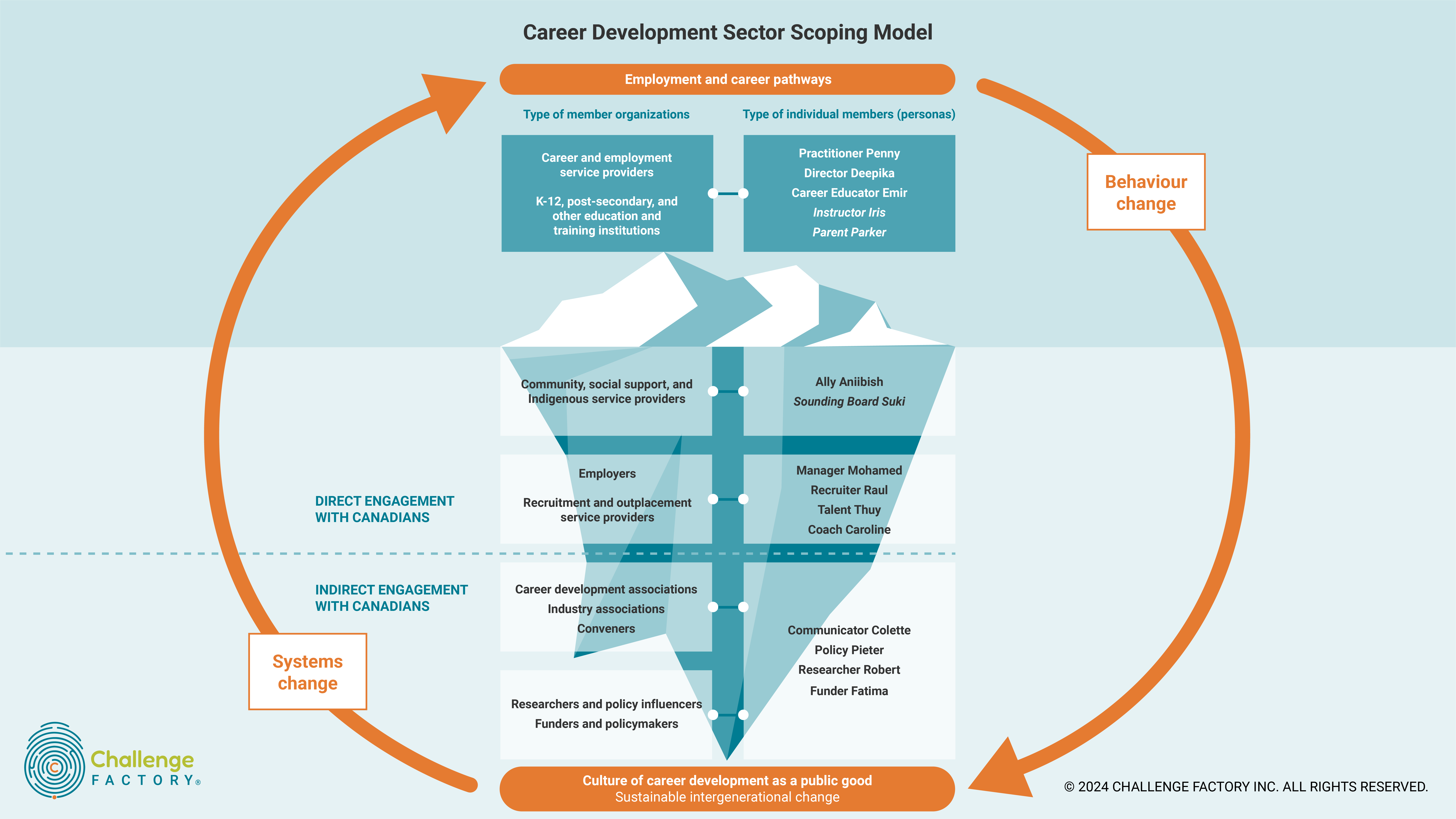|
Getting your Trinity Audio player ready...
|
When Challenge Factory was asked to determine how many people work in Canada’s career development sector, we knew that only taking a headcount would not be feasible or most useful.
A central database of career development professionals does not exist, and much of the sector is hidden even from those who participate in it. The sector also includes frontline practitioners and many other roles and corresponding job titles, and there is significant regional variation in service delivery ecosystems across the country.
To map the sector, we needed a tool that would allow us to identify the types of individuals and organizations that make up Canada’s career development sector, and how they all fit together. The tool we created to achieve this is called the Career Development Sector Scoping Model.
In this article, we explain the Sector Scoping Model by breaking it down into four layers, from simplest to most complex. We use an iceberg diagram to graphically visualize the sector as a cohesive, holistic system of actors that can work together toward a preferred future.
Career Development Sector Scoping Model
Layer 1: Organizations and individuals that make up Canada’s career development sector

The first layer of the Sector Scoping Model identifies 10 types of organizations that make up Canada’s career development sector, as well as 15 personas that represent the types of individuals who are part of the sector.
Personas are detailed profiles, built using qualitative and quantitative research data, that serve as proxies for large categories of people. These personas or characters, which are named and given specific characteristics, embody the key traits, behaviours, needs and goals of the sector’s members.
Lisa Taylor & Taryn Blanchard will be presenting a FREE webinar with CERIC on “Canada’s Career Development Landscape: Hidden Sector, Hidden Talent, and Next Steps Revealed” on April 19. Learn more and register at ceric.ca/webinars.
The first layer shows that the core members of the sector – those involved in career and employment service delivery and the education system – are only the tip of the iceberg. All the members below the tip are also essential contributors to the sector, but are often overlooked and not targeted for professional development or collaboration in efforts to advance the sector or shape a preferred future for all Canadians.
Layer 2: Types of engagement with Canadians and the sector’s shared purposes

The second layer of the Sector Scoping Model identifies which sector members engage directly with Canadians, which members do not and what the outcomes of that engagement are (i.e. the shared purposes of the sector).
Through direct engagement, service providers, professionals in the education system and employers interact face-to-face with Canadians of all ages to guide, support or inform their employment and career pathways. Not all sector members recognize they provide this type of support to Canadians, such as in the relationship between employer and employee.
Through indirect engagement, funders, policymakers, researchers and other policy influencers make critical decisions that affect the work, careers and lives of Canadians, as well as the economy and society more broadly. They hold the key to creating a culture of career development that is prioritized and valued as a public good.
Career development associations, industry associations and other conveners also engage indirectly with Canadians, structuring how the sector advances, learns and collaborates. They bridge the gap between sector members that interact directly with Canadians and the funders and policymakers supporting service delivery.
Layer 3: Types of change that are possible when sector members work together

The third layer of the Sector Scoping Model identifies three types of change that the sector can lead when its members work together: systems change, behaviour change and sustainable intergenerational change.
Systems change is driven by funders, policymakers and the actors who influence them. Meeting the sector’s overarching goal of creating a culture that values career development as a public good requires systems change in a range of dimensions, including how the sector is funded, how policy is formed, what tracking and impact data is gathered, and how research and innovation within the field is coordinated.
Behaviour change is driven by sector members who engage directly with clients, students, workers and other Canadians. They are best positioned to affect their own behaviours and the behaviours of Canadians through the professional quality of their career development knowledge, competencies and resources. Systems change is needed so career development professionals are rewarded for providing quality services.
Creating a culture where career development is recognized as a public good and Canadians can effectively navigate their employment and career pathways with confidence requires both systems and behaviour change. This will take time. Consequently, sustainable intergenerational change is also required, through which positive and enduring transformation is fostered by and across generations.
Layer 4: Sector members responsible for the Career Development Maturity Matrix™ benchmarks

The final layer of the Sector Scoping Model identifies which members of the sector are best positioned to advance each of the four benchmarks in the Career Development Maturity Matrix™: quality, access, cohesion, and capacity.
Created by Challenge Factory and the Canadian Career Development Foundation, the Career Development Maturity Matrix is designed to spark strategic conversation about the foundational elements that the career development sector needs for its structural integrity and advancement in the years to come. It increases our understanding of the Canadian sector’s core strengths, foundational gaps, areas of future opportunity and areas of over-investment across the benchmarks.
- Career and employment service providers and K-12, post-secondary, and other education and training institutions drive the quality of career development practices and service delivery.
- Community, social support and Indigenous service providers, employers, and recruitment and outplacement service providers drive access to career development.
- Career development associations, industry associations and other conveners drive the cohesion of the sector.
- Researchers, policy influencers, funders and policymakers drive the sector’s capacity to fulfill its overall purpose, while ensuring commitment to quality, access and cohesion.
Do you see yourself in the Career Development Sector Scoping Model?
Challenge Factory tackled the complex challenge of mapping Canada’s career development sector by taking a scientific and human-centric approach. We set a key research hypothesis: Focusing on the people in the sector – rather than job titles, places of work or core skills – would lead to the most useful and practical project results.
This hypothesis has proven to be true. When sector members see themselves and the relationships they have with others reflected in the Career Development Sector Scoping Model, mapping the sector shifts from a statistical activity (taking a headcount) to revealing the true impact that career development professionals, advisors, mentors and influencers have on Canadians.
Mapping the sector as a cohesive, holistic system of actors that can work together toward a preferred future also helps everyone – including leaders and policymakers – understand that the system needs attention, and how failing to give it attention jeopardizes a thriving economy and responsive workforce.
Take a look at the Sector Scoping Model and determine if you see yourself reflected in its personas and organizations. If you don’t, let us know.
Consider how the Career Development Maturity Matrix encourages broader collaboration across personas and organizations. If you’d like help using these tools to advance your own impact, get in touch with us today.
To learn more about the project to map Canada’s career development sector, visit challengefactory.ca/hiddensector. Download the executive summary or full report, Hidden Sector, Hidden Talent: Mapping Canada’s Career Development Sector, at ceric.ca/hiddensector.




